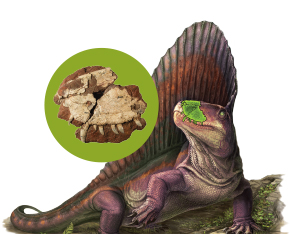
_Ted Daeschler
Daeschler is a professor in the Department of Biodiversity, Earth and Environmental Science in the College of Arts and Sciences and curator and chair of Vertebrate Zoology in the Academy of Natural Sciences of Drexel University.
Since 1845, a segment of an upper jawbone with serrated, inches-long teeth has resided on a shelf at the Academy of Natural Sciences of Drexel University under the name Bathygnathus borealis.
But like many of the millions of specimens at the Academy, this 270-million-year-old fossil still had a story to tell.

Got_Back
Featured in the 1959 movie
“Journey to the Center of the Earth” and many children’s toys, Dimetrodon was a four-legged animal with a spiny, sail-like back ridge.
Researchers from the University of Toronto Mississauga, Carleton University and the Royal Ontario Museum, led by Kirstin Brink, used the Academy’s fossil specimen to determine that Bathygnathus borealis was not actually a unique kind of animal.
By scanning and studying the eight preserved teeth in the jaw, the researchers found the evidence they needed to change the classification of the fossil to Dimetrodon, a “mammal-like reptile” that lived 40 million years before the first dinosaurs.
“They were able to zero in on unique features of this specimen that we’ve suspected for a long time,” says Ted Daeschler, the Academy’s vice president for systemic biology and the library. “The images they were able to develop allowed them to say ‘This is a pelycosaur, specifically Dimetrodon.’”
Dimetrodon is believed to be the first land-based animal to sport “ziphodont” teeth meant for ripping flesh.
The jaw was initially discovered in Canada on Prince Edward Island in 1845. A farmer was digging a new well when the fossil was discovered nine feet down nestled in red sandstone.
With no natural history museum in Canada at the time, the specimen was sold to Joseph Leidy, a prominent paleontologist and curator of the Academy.
Leidy presented and named it at an Academy scientific meeting in 1845.
“He called it Bathygnathus borealis, which means ‘deep jaw from the north,’ basically,” says Daeschler. “That’s how it was back then. They just stood up at those meetings and presented.”
